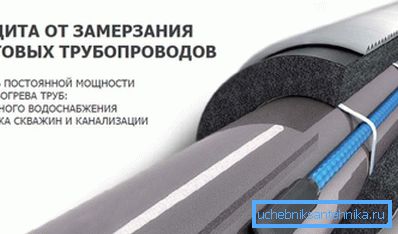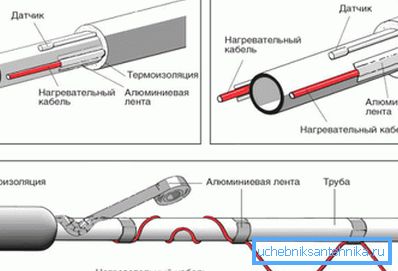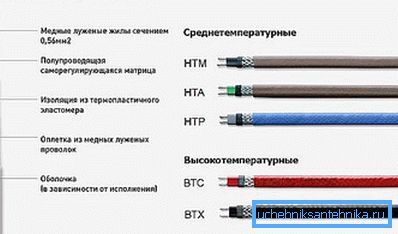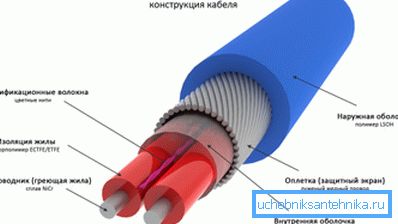Warming cable for pipes: installation and operation features
In this article we will talk about what is a heating cable for pipes, what is its device and how it can be used to avoid freezing of the pipeline. Taking into account the climatic conditions typical for the operation of pipelines in the Russian Federation, it is possible to prevent their freezing and subsequent failure in the cold season, by heating the transported liquid medium.
The use of a special wire allows not only to exclude the probability of formation of ice jams and maintain the required parameters of pressure, but also significantly reduce the depth of water pipelines.

Variety of heating cable

The timely heating cable for pipes on the market is represented by a wide range of products of foreign and domestic manufacturers. And that is why it is so important to understand which product, for what purposes it is intended and what should be purchased, and what is better to refuse.
Conventionally, the entire cable for heating water pipes is presented:
- resistive modification;
- self-adjusting modification.
Both types of heating have unique characteristics that should be considered when choosing and installing. Consider the technical and operational characteristics of both modifications as detailed as possible.
Resistive cable

A resistive cable for heating pipes is one, usually two, spiral-shaped thin conductors coated with polymer insulation. The main advantage of this option is a reasonable price.
Important: The cable presented on sale, is realized by segments of a certain length with the corresponding resistance. Therefore, it is necessary to immediately select the appropriate size, since it will not be possible to cut the purchased wire to an arbitrary length.
Single wire connection is made from both ends. Strong modification from one end is short-circuited, and from the other end it is connected with the hands to the power source. The choice of a strong wire is more preferable, since it needs half as much as in the case of a single-core cable.
A technologically advanced version of resistive heating wire is a zonal sectional cable. Structurally, the system is a main cable, along which two wires with low resistance are located.
Between these wires, at some distance from each other, segments of spiral conductors are connected. Zonal modification of the heating wire is more expensive than the usual analog, however, such a wire, if necessary, can be cut in accordance with a suitable length.
The disadvantages of resistive cables include the possibility of overheating, the likelihood of cold zones, both at the beginning and at the end of the circuit.
Among the advantages we note such qualities as:
- low price;
- long-term constant power;
- zero probability of inrush current;
- ease of installation;
- reliability and durability of the system as a whole;
- operational safety.
Self-regulating cable

A self-regulating cable for heating pipes consists of two conductors enclosed in a common polymer sheath. In accordance with the ambient temperature changes the resistance of the conductors, as a result, the heat output is regulated at each point of the wire automatically.
This kind of cable is manufactured adapted to a specific temperature, for example, you can purchase a modification designed for the melting ice temperature.
The wires are marked with the appropriate marking, in which such indicators as the meter per meter power at + 10 ° C and power at minus ambient temperature are indicated.
Cables of this type are economical, reliable and safe in operation. The wire can be cut to the desired length, which eliminates the waste of material during installation.
Important: Self-regulating heating systems require a professional approach to installation work. In case of insufficient quality installation of the end and adapter sleeves, the failure of the entire heating system is possible.
Resistive wiring operation
This type of wiring functions as an ordinary electric heater, and therefore the installation and operation of the device does not seem to be particularly difficult.
As already mentioned, in accordance with the method of connecting to the power supply resistive wiring is divided into single-core and two-core:
- Single core heating wire - This is a single conductor, covered with insulation, shielded by a braid and an upper polymer sheath, providing the required degree of tightness.
Since the cable is connected on both sides, it should be looped, with the result that both ends are located in the same place where the connection is made. The most rational method of installation is installation on both sides of the pipe.
Single-core resistive wiring can only be laid on the outside and there are a number of good reasons for this:
- Laying single-core cable in the cavity of the pipe will take double the volume, which is likely to result in a decrease in water pressure and subsequent blockages;
- The internal arrangement will most likely turn into an interlacing of the wire, which, most likely, will lead to its overheating and subsequent failure.
- Preheating the pipe with a twin-core cable is an order of magnitude more efficient and easier.. Heating is carried out on two veins, and therefore do not need to lay out a loop.

This advantage makes it possible to position the wiring with the same success both outside and inside the pipe. Due to the fact that the wires are connected together in one braid, the location of the wiring inside the pipe will not affect the pressure and will not lead to clogging.
The installation instructions for a two-core heating cable involve the insertion of a tee into a pipe. Perpendicular tap is used to insert the resistive cable inwards. In order for the water passing through the pipes to not go outside, a special hermetic coupling is installed on this outlet.
Conclusion
Now you know what a wiring is to warm up the pipeline. Guided by the above information, you can protect the pipeline from freezing and ensure maximum efficiency of its operation.
You can find more useful information on heating pipes with a cable by watching the video in this article.